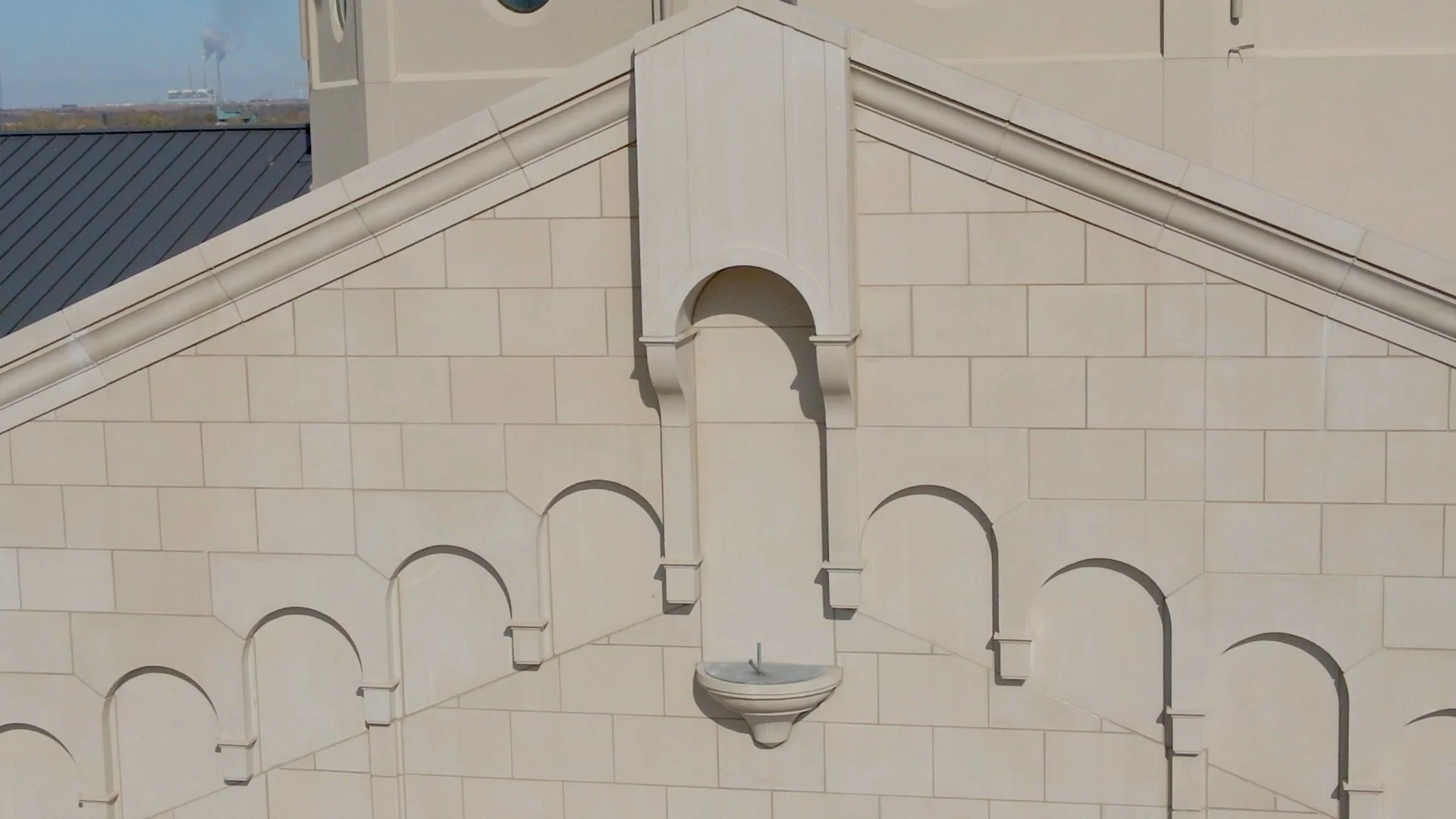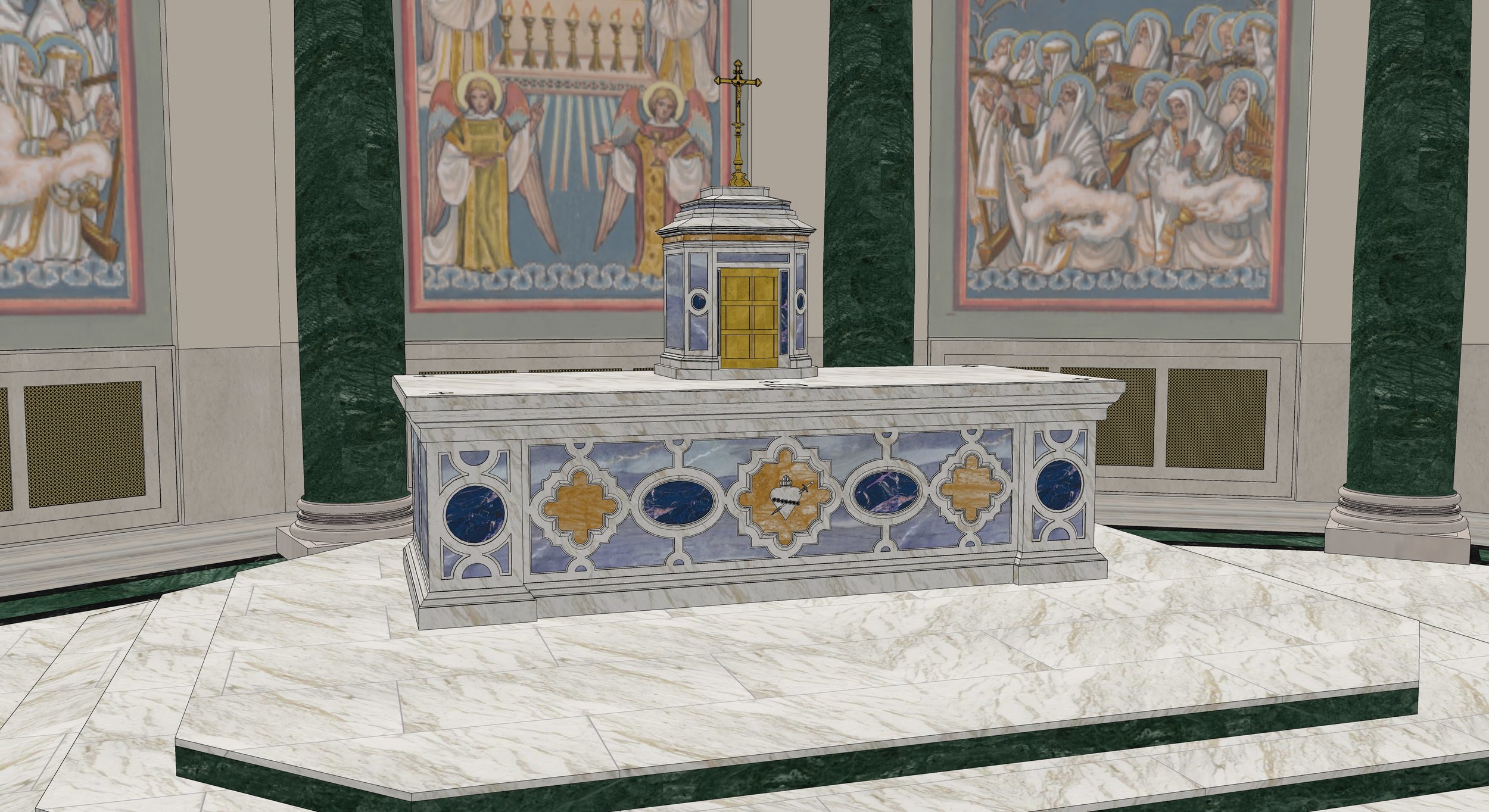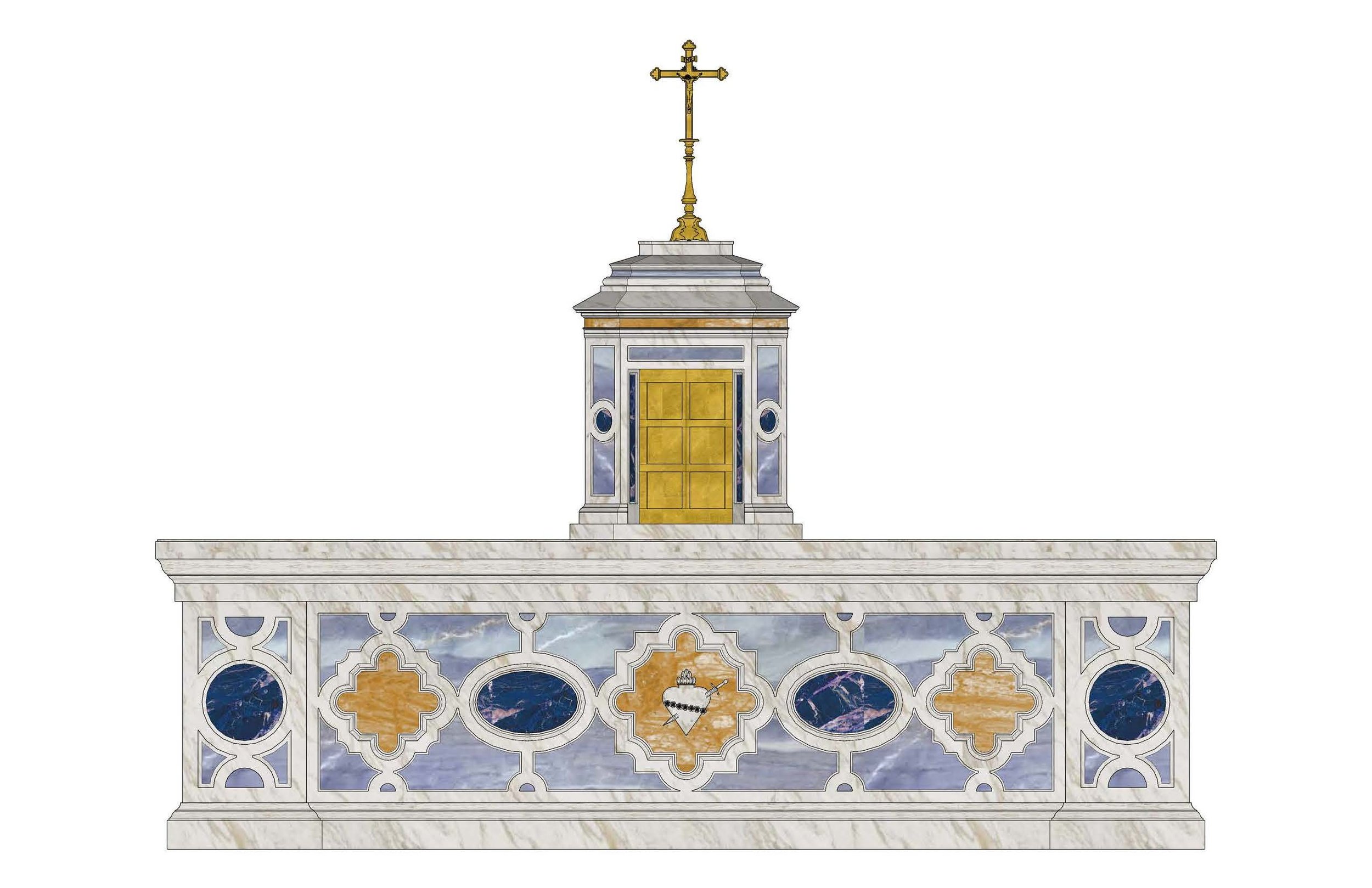Behind the Scenes: November 2022 Update
What is an altar? What aspects must be considered when building the altar for a church? This monthly video describes the process, and Fr. Rutledge explains why a free-standing altar has been chosen for The Immaculata.
And a new event reminder! Weather permitting, the statue of Our Lady will be raised to the cupola this week, on Thursday, November 3rd.
Transcript of the Video
[Bill Drew] Welcome back to the Immaculata Church Project here in St. Marys, Kansas. Today we are going to give you a construction update video and Father Rutledge is going to talk about the main altar.
So progress on the exterior: we have gotten some of the retaining walls on the north side in; for the hardscapes, we got some more sidewalk and stairways in. They will be clearing that north lot over the next weeks and we will start seeing some curb and gutter and that parking lot will be paved. The roofers are almost complete: you can see they are working on the gutters and downspouts. We have the bells installed; all five bells are installed and operable.
As you can see there is a building here to my left: that building contains four statues. It contains the large statue of Our Lady that is going on the cupola, Christ the King in the front façade, and St. Cyril of Alexandria on the north transept and then St. Louis de Montfort on the south. In a few more days, on November 3 or 4, depending on the winds, those statues will be installed with a crane.
Now let's go inside and we’ll look at the progress in there.
So on the interior we did get a lot of stone installed. Here I am standing next to some of the chancel pierstone. Most of the pilaster here behind me and across the way you can see are on. Capitals are installed. All the narthex columns are in. We have gotten all of the artwork on the ceiling complete; it's been inspected and they are taking the scaffolding down. So as the scaffolding system comes down in the crossing and transepts, and once those materials are cleared, that will make way for our stone installation guys to come and start flooring and then do the stone flooring in the sanctuary here.
Now we are going to turn it over to Fr. Rutledge and he is going to talk about the main altar.
[Fr. Rutledge] So we have spoken in our last number of videos about a lot of the other aspects of the church, the artwork and many other individual elements.
Today we are going to look at the most important part of a church which is the main altar. I want to talk about its significance, its preciousness, and some of the thoughts that went into the design. I do ask that you watch this entire video, especially if you plan on making any comments, because I think that there is nothing more misunderstood than what the Church requires of an altar, and maybe even what an altar actually is. We spoke about some of these things in our April update video event of last year, but at that time we hadn’t gone into too much detail of the design of the altar, so we will be able to explain a little bit of that to you as well.
Architectural rendering of the Immaculata’s main altar and sanctuary
The Immaculata’ main altar is a free-standing altar, which means that it is detached from the back wall of the sanctuary. Since the Immaculata was designed taking a lot of inspiration from Roman basilicas, where free-standing altars are the tradition and fit the architecture, our sanctuary too was designed with such an altar. We love this Roman feature of the Immaculata because it links us with architectural tradition and it allows for the performance of the liturgy in its perfection in even less essential details. The free-standing altar was the norm for Catholic churches until about the 8th century when other elements of altar design came in. And we saw about that time some more vertical elements being attached to the back of the altar – which we call nowadays gradines and reredos. Gradines are basically the shelves attached to the back of the altar on which the candlesticks, relics, flowers often go.
Reredos are the vertical walls or screens attached to the back of the altar which often have sculptures or other architectural features. Reredos are used often when a sanctuary is smaller and the altar is pushed back against the wall. The goal of using them is to give a prominence to the altar but within a limited space. This style is extremely common, for example, there was an altar that I installed in Pittsburgh that has reredos due to a much smaller sanctuary, or even the SSPX’s church in Denver has very ornate reredos that are very beautiful and all of marble. You can see here I even have a book from the 1920’s; it's basically a catalog of altars that people could select for their churches with different reredos and such. They are all very beautiful and all these styles are accepted by the church. There may be some liturgical preferences to our free-standing altar, but that isn’t a question of any one of these styles being bad or forbidden. So before we talk more about the preciousness of our free-standing altar, let’s first understand what an altar is.
Architectural rendering designed by Civium of the Immaculata’s altar
What is an altar? There are three elements to an altar: the mensa, the stipes and the sepulcher. The mensa is the top flat part of the altar. The stipes are the supports which are sometimes walls or sometimes columns. And then there is the sepulcher which is the cavity on the top of the altar that receives two relics and three grains of incense. That is what an altar is and nothing more. You might say then, ‘well, Father is saying that an altar is a table’. Well, structurally speaking, yes it is and it has always traditionally been so, but of course we know that it becomes much more than a table by its consecration. It isn’t just a table where a meal takes place, as is so often emphasized today in modern Catholic churches and where the priest faces the people, rather it is an altar made of stone, showing its permanence, on which the sacrifice of Our Lord Jesus Christ is daily offered. It is a place of real immolation. That is why we place the relics of martyrs in the altar and also why we insist on having three linen altar cloths on the altar, as is traditionally done. They point to the sacrificial nature of the Mass. And that is why in our consecration ceremony of the church, probably the center point of that consecration, is the consecration of the altar.
To further show this permanence of our main altar made of stone, we even have poured a concrete column substructure under the altar that goes all the way through the basement to the church’s foundation.
So, to me the beauty of the free-standing altar is that it emphasizes the altar itself. It is like a holy mountain in the middle of the sanctuary, like Moriah where Isaac was almost immolated or more properly speaking like Calvary where Our Lord was immolated, where The Sacrifice is offered.
So our altar is seven steps above the main level of the nave, and so it is quite elevated from where the faithful sit and they will be able to see this ‘holy mountain’, if you will.
The verticality and focality, shall we say, making the altar the focal point, was achieved in a different way than using reredos. And here I kind of want to take you on a visual progression so that you can see that our altar and sanctuary has immense vertical and visual elements that emphasize the altar. So, back behind our altar we have a very large colonnade of green marble columns. These are the only green marble columns going in the church. All the other 50 columns and pilasters in the church have been clad in a limestone, so that it makes these columns in the sanctuary stick out emphatically. They will also tie into the floor design in colors so that one’s sight from even the back of the church will naturally be drawn up to the sanctuary.
Also we have so much artwork, as we explained even in our September video, going into the five bays of the ambulatory going back behind the altar, this central bay with the Paschal Lamb will have gold leafing all around the Lamb to make it stand out beyond the simple metallic gold paint everywhere else in the church.
So, we could have had reredos, we could have had a baldachin with four columns around the altar, but we have something even more impressive with an 8-column colonnade, and artwork spanning the entire back of the sanctuary with up to 30 vertical feet of artwork.
But don’t you have to have a baldachin over a main altar? No, not necessarily. Even the Congregation of Rites recognized that this requirement even in Rome had even fallen into disuse, especially if the architecture already shows good taste.
So in this next section what I want to talk a little about is the preciousness of stone going into our altar. We have four very beautiful types of stone going into the altar, two of which are extremely rare and precious. We have a white marble that is called Volakas, and it is quarried from the mountainside of Falakro in Drama, Greece. This all-white marble has gray and brown veining and for this reason it is called the “Carrara of Greece.” There is also a gold marble going into the altar which comes from Turkey and adds to the sense that the altar is a place of divinity, where God’s glory is promoted, and where God even dwells in the tabernacle. And then there are two different blue stones that are being incorporated into the altar, not only as a way to bring a Marian theme to the main altar, but also because these stones are so precious. The lighter blue is called Ocean Blue and it comes from Brazil. It is a quartzite which has a smooth and lustrous appearance, and is a very strong stone. The other darker blue is a granite, also from Brazil, called Lapis Lazuli. Blue is the rarest color of stone in the entire world, it’s the most expensive stone as well, which is why these blue stones cost easily more than ten times the amount of the other stones going into the Immaculata.
Architectural rendering designed by Civium of the Immaculata’s altar
So this blue has historically been called more precious than gold, so by incorporating that blue stone into a relatively simple altar design we are truly making the main altar the most precious object in the church, as we should rightly do, and through using a stone that is both visually stunning and extremely rare.
And because this blue was often used even in the Renaissance era to depict Our Lady’s garment, it being a heavenly color, I kind of like to think too of the use of this blue as sort of Our Lady enshrining Our Lord, sort of like the Pieta where Our Lord in His sacrifice is clothed in Her garment. That’s just a personal take on it, but I think it is a little bit of how we can see this main altar.
So I said earlier we do have a very large altar, the altar being what it is. Our altar is 11’4” long and 5’ deep. This is a size proportionate to the size of our church and sanctuary and it certainly is large enough to accommodate the large number of ciboria that will be consecrated on it daily. Our tabernacle is also very large and will be encased in marble, but with a bronze circular interior, and it will fit up to 6 ciboria for our very largest Masses here where we will have six priests distributing communion.
And at the center of the altar front or shall we say in the center of the altar’s supports or stipes, as I mentioned earlier, in a central medallion, there will be a carved relief of the Immaculate Heart of Mary, which we will gold-leaf, and this too will add to the overall preciousness of this main altar and pointing to the church’s theme of her Immaculate Heart. On our altar’s mensa too, because of its size and depth, we will go 10 candlesticks along with plenty of other space for relics and flowers.
So as you can see we have an altar that is being made with the most precious materials possible, the most precious materials in the entire church that will symbolize Our Lady and Her Immaculate Heart. We have an altar on which all the liturgical functions can happen and we have a place that expresses permanence on which the Sacrifice of Our Lord Jesus Christ can be daily offered.






















